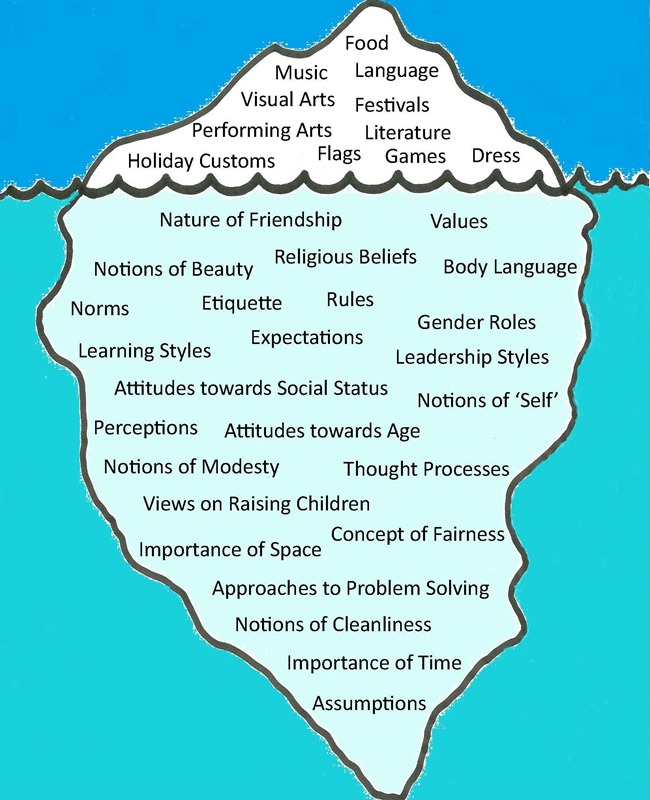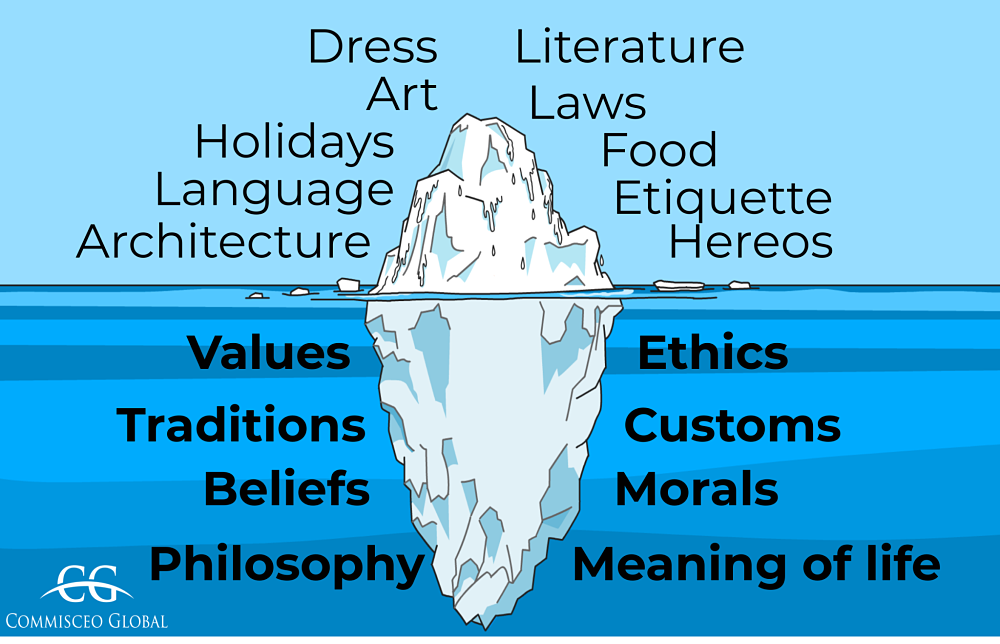
Understanding the Iceberg Model of Culture Xoxoday
Culture of the Classroom/School Icebergs: A second potential practice is a slight variation on the cultural iceberg in which students can create cultural icebergs focusing on the classroom and school community cultures.The teacher should also complete an iceberg. As a class you can compare the teacher's iceberg to the students' and discuss areas where the teacher's perception of the classroom.

PPT The Iceberg Model of Culture PowerPoint Presentation, free download ID6872279
The iceberg model of culture or cultural berg is used as a ordinary metaphor, but wie well do you knowledge it? Before we deep dive into its layers and their key in einer organization, let's understand it on a high level. Hall's Cultural Iceberg Model.

THE CULTURAL ICEBERG ? CAMHS Professionals
The Iceberg Model of culture (adapted from Rogers and Steinfatt, 1998) Source publication TOWARD AN INTEGRATED APPROACH TO LANGUAGE, CULTURE AND COMMUNICATION IN THE FOREIGN LANGUAGE CLASSROOM.

The Iceberg Model of culture (adapted from Rogers and Steinfatt, 1998) Download Scientific Diagram
As Torben Rick puts it, the iceberg represents "the way we say we get things done" in contrast to the deeply-ingrained "way that things actually get done" within an organization.. In other words, for managers to positively affect cultural change, they not only need to address the top of the iceberg (vision, mission, values, etc.) but they must also make inroads on the bottom of the.

Resource The Cultural Iceberg Model
" Iceberg Model of Culture ," established by Edward T Hall in 1976, describes how organizational culture is like an iceberg found in the cold waters of the Arctic. Only 10% of an iceberg is visible above water, while the rest is submerged under it; this is known as the "iceberg effect."

Corporate cultural iceberg template on surface is visible elements and underwater is invisible
An Analogy of Culture. Within intercultural training though there is one model or analogy of culture that most agree sums up the concept best; and that is the iceberg. The iceberg perhaps lends itself best to this as it so graphically demonstrates the idea of having both a visible and invisible structure. Furthermore, the fate of the Titanic.

How to Use The Iceberg Model of Organisational Culture
Hall's iceberg model was developed in 1976 by American anthropologist and cross-cultural researcher Edward T. Hall. Hall likened corporate culture to an iceberg. He posited that some aspects of culture were: Visible (above the waterline) - such as vision, mission, strategy, external presentation, and policies.

Le Modèle de l'Iceberg Culturel de Hall — Wiki Agile
Edward T. Hall's Cultural Iceberg Model In 1976, Hall developed the iceberg analogy of culture. If the culture of a society was the iceberg, Hall reasoned, than there are some aspects visible, above the water, but there is a larger portion hidden beneath the surface. What does that mean? The external, or conscious, part of culture is what we.

Visualising the Iceberg Model of Culture
The Iceberg Model of Culture. Source publication +31 A Case Study on Increasing Intercultural Communicative Competence: Exploring Skills, Attitudes, and Knowledge Thesis Full-text available Mar.

Iceberg model of corporate culture by Edward Twitchell Hall (1989). Download Scientific Diagram
The iceberg model helps to show us that a few easily visible elements of culture are above the surface but that below the surface lie the invisible and numerous elements that make up culture. Ethnocentrism is an important word to know; it indicates a mindset that your own culture is superior while others are inferior.

The Iceberg Model of Culture Download Scientific Diagram
Iceberg Model of Culture September 28, 2022 A strong culture is a vital component of any thriving organization. Yet, this is a concept that many company leaders find relatively elusive. In some ways it can feel like an intangible idea, based around values and attitudes.

The Iceberg Model of Culture. Download Scientific Diagram
The concept of the cultural iceberg was coined in 1976 by Edward T. Hall, who suggested that culture is analogous to an iceberg in that only about 10% of the iceberg is visible at any given time and that a large part of it is hidden beneath the surface.

Intercultural Training and the Iceberg Model
The iceberg model of culture is a detailed structure of parameters that helps you determine the quality of your organizational culture. Based on the analogy of an iceberg that has both a visible and hidden portion, this model assesses the effectiveness of an organization's visible and hidden cultural elements.

What’s a Cultural Iceberg? Expat with Kids
1.3 The culture iceberg When you observe people from a certain culture, some characteristics - such as dress and the way people greet each other - are easy to see. Others are not so easy. Culture is sometimes compared to an iceberg, some of which is visible, but much of which is difficult to see, or invisible. A B C

Iceberg Model of Culture Terryberry
In 1976, Edward T Hall developed the 'Iceberg Model of Culture' and explained that organizational culture is like an iceberg that's found in polar seas. What you see is just the tip of the iceberg. Underneath lies an enormous, invisible mass, which holds everything together strongly. Table of Contents

Cultural Iceberg Model Wiki Eurth
The term 'Iceberg Model of Culture' is inspired by the icebergs found in polar seas. An iceberg has visible parts on the surface of the water and invisible parts that are underwater. Often, up to 90% of an iceberg's actual area remains hidden underwater. Similarly, culture and behaviors have both visible and invisible components.